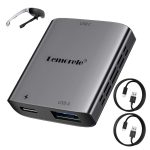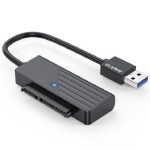In today’s digital age, having multiple monitors can significantly enhance productivity and multitasking capabilities. Whether you’re a gamer, content creator, or simply someone who likes to have several windows open at once, connecting two monitors can make a world of difference. But can you connect two monitors using HDMI? The answer is yes, absolutely! However, there are a few things to consider before you get started. This article will explore the various methods and considerations for connecting two monitors via HDMI.
Contents
- 1 Checking Your Computer’s HDMI Ports
- 2 Choosing the Right HDMI Splitter
- 3 Connecting Monitors with an HDMI Splitter
- 4 Benefits of Docking Stations and USB-C Hubs
- 5 Choosing the Right Docking Station or USB-C Hub
- 6 Connecting Monitors with a Docking Station or USB-C Hub
- 7 Benefits of USB-to-HDMI Adapters
- 8 Choosing the Right USB-to-HDMI Adapter
- 9 Connecting Monitors with a USB-to-HDMI Adapter
- 10 Troubleshooting Common Issues
- 11 Ergonomic Considerations
- 12 Conclusion
Checking Your Computer’s HDMI Ports
First and foremost, you need to check how many HDMI ports your computer has. Most modern laptops and desktops have at least one HDMI port, but some may have two or even more. If your computer has two HDMI ports, connecting two monitors is a straightforward process. Simply plug one HDMI cable into each port and connect them to your monitors.
If your computer only has one HDMI port, don’t worry. You can still connect two monitors using an HDMI splitter. An HDMI splitter is a small device that takes the video signal from your computer’s HDMI port and duplicates it to two or more output ports. This allows you to connect multiple monitors to a single HDMI source.
Choosing the Right HDMI Splitter
When selecting an HDMI splitter, there are a few factors to consider:
- Resolution Support: Make sure the splitter supports the resolution of your monitors. If you have 4K monitors, you’ll need a splitter that supports 4K resolution.
- Number of Ports: Choose a splitter with enough ports for the number of monitors you want to connect.
- Active vs. Passive: Active splitters typically offer better performance and support for longer cable runs, but they are more expensive. Passive splitters are more affordable, but they may have limitations on resolution and cable length.
Connecting Monitors with an HDMI Splitter
To connect two monitors with an HDMI splitter:
- Plug the HDMI splitter into your computer’s HDMI port.
- Connect your monitors to the splitter using HDMI cables.
- Turn on your computer and monitors.
- Your computer should automatically detect the additional monitors. If not, you may need to adjust your display settings.

Another option for connecting two monitors to a computer with a single HDMI port is to use a docking station or a USB-C hub. These devices offer multiple ports, including HDMI, allowing you to connect various peripherals, including multiple monitors.
Benefits of Docking Stations and USB-C Hubs
Expand Connectivity
Docking stations and USB-C hubs can significantly expand the connectivity options of your computer, allowing you to connect multiple monitors, external hard drives, keyboards, mice, and other devices.
Simplify Your Setup
By connecting all your peripherals to a single docking station or hub, you can reduce cable clutter and make it easier to connect and disconnect your devices.
Charge Your Laptop
Many docking stations and USB-C hubs also offer power delivery, allowing you to charge your laptop while using it with multiple monitors.
Choosing the Right Docking Station or USB-C Hub
When selecting a docking station or USB-C hub, consider the following:
- Compatibility: Make sure the device is compatible with your computer’s operating system and ports.
- Number of Ports: Choose a device with enough ports for all your peripherals, including the number of monitors you want to connect.
- Power Delivery: If you want to charge your laptop through the docking station or hub, make sure it supports power delivery.
- Features: Some devices offer additional features such as Ethernet ports, audio jacks, and SD card readers.
Connecting Monitors with a Docking Station or USB-C Hub
To connect two monitors with a docking station or USB-C hub:
- Connect the docking station or hub to your computer.
- Connect your monitors to the HDMI ports on the docking station or hub.
- Turn on your computer and monitors.
- Your computer should automatically detect the additional monitors. If not, you may need to adjust your display settings.
If your computer doesn’t have enough HDMI ports or you want to connect additional monitors beyond two, you can use a USB-to-HDMI adapter. These adapters allow you to connect an HDMI monitor to your computer’s USB port.
Benefits of USB-to-HDMI Adapters
- Add More Monitors: USB-to-HDMI adapters allow you to connect additional monitors even if your computer doesn’t have enough HDMI ports.
- Flexibility: You can use USB-to-HDMI adapters with laptops and desktops, providing flexibility for different setups.
- Portability: These adapters are usually small and portable, making them easy to carry around.
Choosing the Right USB-to-HDMI Adapter
When choosing a USB-to-HDMI adapter, consider:
- Resolution Support: Make sure the adapter supports the resolution of your monitor.
- Compatibility: Check that the adapter is compatible with your computer’s operating system.
- Performance: Some adapters may have limitations on performance, especially when handling high resolutions or multiple monitors.

Connecting Monitors with a USB-to-HDMI Adapter
To connect a monitor with a USB-to-HDMI adapter:
- Plug the USB-to-HDMI adapter into your computer’s USB port.
- Connect your monitor to the adapter using an HDMI cable.
- Install any necessary drivers for the adapter.
- Your computer should detect the additional monitor. If not, you may need to adjust your display settings.
Connecting two monitors with HDMI is definitely possible, even if your computer only has one HDMI port. You can use an HDMI splitter, a docking station or USB-C hub, or a USB-to-HDMI adapter to achieve this.
Remember to consider the resolution support, number of ports, and compatibility when choosing the right solution for your needs. With the right setup, you can enjoy the benefits of a multi-monitor setup and boost your productivity and multitasking capabilities.
Troubleshooting Common Issues
Even with a seemingly straightforward setup, you might encounter some hiccups when connecting two monitors with HDMI. Let’s tackle some common issues and their solutions:
No Signal on One or Both Monitors:
- Check Cable Connections: Ensure all HDMI cables are securely plugged into both the computer/splitter/hub and the monitors. Sometimes, a loose connection can cause signal issues.
- Restart Devices: Try restarting your computer and monitors. This can often resolve minor glitches that prevent signal detection.
- Update Drivers: Outdated graphics drivers can sometimes cause compatibility issues. Make sure your computer’s graphics drivers are up to date.
- Check Display Settings: Go to your computer’s display settings and ensure that the second monitor is detected and enabled. You may also need to adjust the resolution or refresh rate to match the monitor’s capabilities.
Ergonomic Considerations
When setting up multiple monitors, it’s essential to consider ergonomics to prevent eye strain, neck pain, and other discomforts.
- Monitor Placement: Position your monitors at a comfortable viewing distance, about an arm’s length away. The top of the monitors should be at or slightly below eye level.
- Monitor Angle: Tilt your monitors slightly upward to reduce glare and neck strain.
- Lighting: Ensure adequate lighting to minimize eye strain. Avoid placing your monitors directly in front of a window or other bright light source.
- Take Breaks: Get up and move around regularly to prevent muscle fatigue and promote blood circulation.

Conclusion
Connecting two monitors with HDMI is a relatively simple process that can greatly enhance your productivity and workflow. Whether you’re using an HDMI splitter, docking station, USB-C hub, or USB-to-HDMI adapter, you can enjoy the benefits of a multi-monitor setup.
Remember to consider the resolution support, number of ports, and compatibility when choosing your equipment. By following the tips and troubleshooting advice in this article, you can create a seamless and efficient multi-monitor environment that caters to your needs.
So, go ahead and expand your digital workspace – the possibilities are endless!


